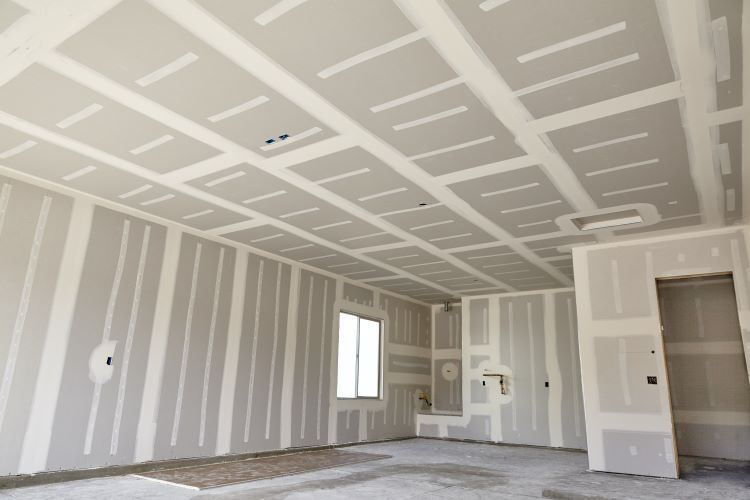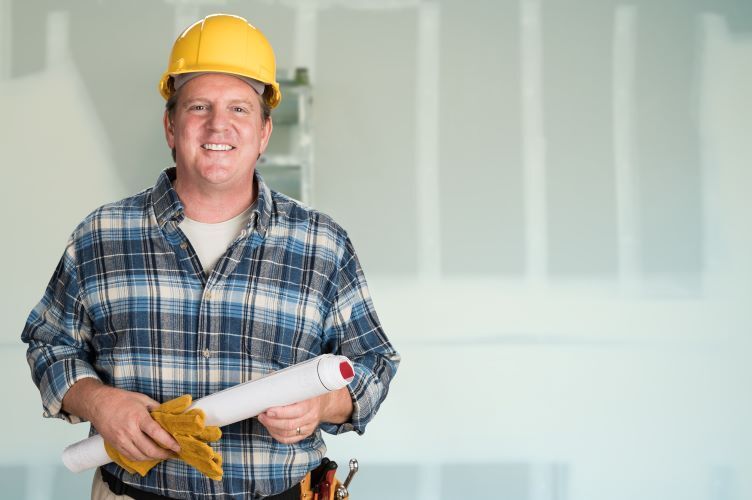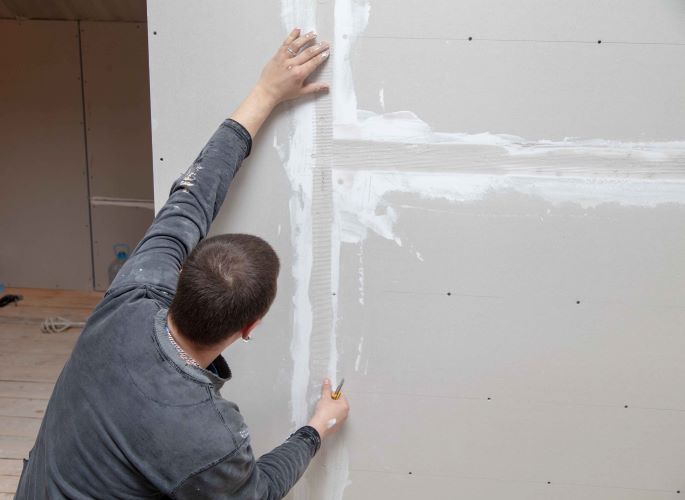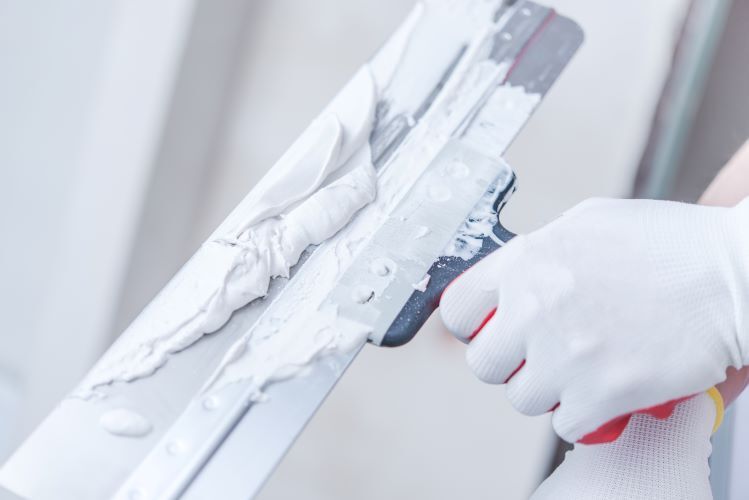Drywall Taping and Finishing Services
What is taping and finishing?
Drywall taping and finishing are both processes related to the final touches of a drywall project. The taping is directly as it sounds, where tape is applied to the adjoining surfaces between drywall sheets. The finishing is also referred to as "mudding". This mudding process, as the name suggests, refers to using drywall mud to cover over the tape that has been applied. Without the proper procedure and application of the tape and mud, your drywall project will end up looking unfinished. The main objective of this part is to smoothly cover all the cracks in between the gypsum board sheets which are now fixed firmly onto the wall. The entire process takes patience and many steps, beginning with careful taping along the crevices where the drywall sheets come together. Once the tape is in place, a very detailed application of the “mud”, or drywall compound, will be spread across the areas that have been taped, quite often the mudding process will require multiple layers of drywall compound. Once the mud has dried, it takes careful sanding the smooth out the areas to a completely, and perfectly, finished looking wall or ceiling.
Drywall taping and finishing are both processes related to the final touches of a drywall project. The taping is directly as it sounds, where tape is applied to the adjoining surfaces between drywall sheets. The finishing is also referred to as "mudding". This mudding process, as the name suggests, refers to using drywall mud to cover over the tape that has been applied. Without the proper procedure and application of the tape and mud, your drywall project will end up looking unfinished.
The main objective of drywall finishing is to smoothly cover all the cracks in between the gypsum board sheets which are now fixed firmly onto the wall. The entire process takes patience and many steps, beginning with careful taping along the crevices where the drywall sheets come together. Once the tape is in place, a very detailed application of the “mud”, or drywall compound, will be spread across the areas that have been taped, quite often the mudding process will require multiple layers of drywall compound. Once the mud has dried, it takes careful sanding the smooth out the areas to a completely, and perfectly, finished looking wall or ceiling.
We work with drywallers all around the globe. Check out our friends at Drywall Contractor Grand Rapids, MI
Request a free estimate!
We will get back to you as soon as possible.
Please try again later.
Drywall Taping
Applying the drywall tape helps to bond together the bordering sheets of drywall. This task involves using either fiberglass or paper tape, and it also requires extreme attention to detail. Deciding between the type of tape will vary from job to job, fortunately our team is experienced with both forms of application. It is very important to understand the details behind the taping process.
Paper Tape
Paper tape is non adhesive, so it must be applied with a drywall compound adhesive. Because of this, it must be applied as smooth and as flat as possible, neglecting this detail could lead to “tape bubbles”. These bubbles will appear on the surface of your finished drywall and will give it a very off-putting look. Our drywall experts have years of experience and ensure a pristine finish to your walls and ceilings.
Fiber Glass Tape
This type of drywalling tape is a self adhesive form of tape. This means it can be applied without the use of a drywall compound. The fact that it is self adhesive tape means a much speedier process can be in place. Although fiber glass tape is generally quicker to use, there are some applications which require paper tape, such as a 90 degree angle on a wall where an extremely crisp finish must be achieved. We always use fiber glass tape when possible, to assure we can get your job finished on time and within budget.
The taping is arguably the most difficult part of a perfect drywall finish, leaving this to the pros is always a wise decision. For more information on this process please contact us, we would love to speak with you!

Exceptional Drywall Services, on Budget, on Time
Button
Contact our team for all your painting services too. Part of our drywall finishing includes the painting process as well, and we even offer exterior painting services!
Make sure to allow a minimum of 24 hours for the mud drywall compound to dry before getting started with any sanding.
Drywall Mudding
The mud that is used during the mudding process is a drywall joint compound which has been formulated to strengthen and smooth drywall and drywall joints. This process can often be referred to as drywall texturing. All purpose mud works best for the initial base coat to get that first spread smoothly covered across all the taped areas. Each time a layer of mud is evenly distributed across the surface it requires a considerate amount of time to dry, often this will take 24 hours. Once the compound has dried it will then be sanded down to a perfectly smooth and consistent finish, although this entire process will normally need to be repeated several times to get a perfect looking finish.
There are varying levels of sandpaper that can be used for the sanding, this will depend on if more mud applications are needed, or if you are sanding to a final product. When the surfaces appear ready to be finished, a topping type of mud can then be used to finish covering any remaining cracks, along with any holes caused by nails and screws. The surfaces can then be sanded down one final time with an appropriate finishing type of sandpaper. This process takes time but when done right you will be left with an absolute pristine finish that will leave you with total satisfaction.
The mud that is used during the mudding process is a drywall joint compound which has been formulated to strengthen and smooth drywall and drywall joints. All purpose mud works best for the initial base coat to get that first spread smoothly covered across all the taped areas. Each time a layer of mud is evenly distributed across the surface it requires a considerate amount of time to dry, often this will take 24 hours. Once the compound has dried it will then be sanded down to a perfectly smooth and consistent finish, although this entire process will normally need to be repeated several times to get a perfect looking finish. There are varying levels of sandpaper that can be used for the sanding, this will depend on if more mud applications are needed, or if you are sanding to a final product. When the surfaces appear ready to be finished, a topping type of mud can then be used to finish covering any remaining cracks, along with any holes caused by nails and screws. The surfaces can then be sanded down one final time with an appropriate finishing type of sandpaper. This process takes time but when done right you will be left with an absolute pristine finish that will leave you with total satisfaction.

Professional. Trusted. Quality.
London Drywallers
Button
We bring pride and passion to every project that we undertake, with a professional team of drywall contractors determined to bring you a quality finish, every time.



